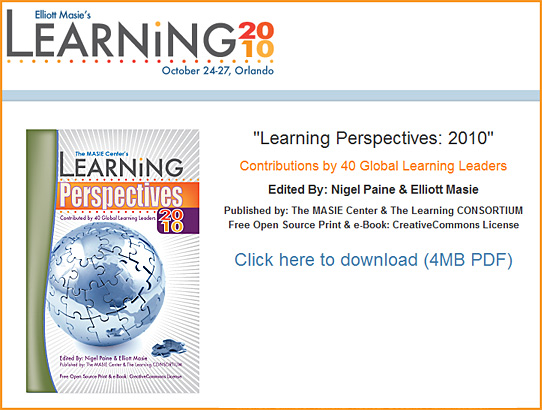Learning TRENDS by Elliott Masie – Nov 3, 2010.
#646 – Updates on Learning, Business & Technology.
55,181 Readers – http://www.masie.com – The MASIE Center.
Excerpt:
Learnings from Learning!
Here were a few of my learnings – as a I interviewed our keynoters and interacted with the 1,700 colleagues:
* Intensity Matters:
I chatted with Apolo Ohno about the role that intensity played in training for his performance at both the Olympics and Dancing with the Stars. The answers were all about intensity and focus. He knew that to reach the “1%” level of performers, he had to engage in a long term intensity of training. This meant coaches, numeric feedback and framework shifts. I started and ended my interview with Apolo chatting about the role that his father played in his performance. And, his 2% level of body fat was a level of intensity that took the breath of the audience away 🙂
* From Social to Engagement:
Several of our speakers drilled down on the role of social media and social networks for learning and development. The challenge for designers will be to use these technologies and methods for deeper employee engagement – and to develop models that are deep and meaningful rather than wide and superficial. A number of speakers commented about the hype and “ghost town” quality of many internal social networks – that start with a big bang but don’t really impact the daily lives of employees or assist them with performance.
* Quiet on the e-Learning Brand:
I realized that none of our main stage speakers and few of the breakout speakers used the word “e-Learning”. The discussions were clearly about leveraging technology for learning – from JCPenny using their cash registers to deliver video messages from the CEO to the Peace Corps using smart phones to display instructional videos in the field, but the “e-Learning” brand seems to be rapidly shrinking. Traditional branched CBT like modules seem to be growing mainly in the compliance arena, where more learner driven content formats are expanding in the performance arena. We have never seen more learning using technology for design, delivery or collaboration. But, the “e” is dropping away in the branding.
* 30 Under 30 Rocks:
It was a delight to host our 30 Under 30 group of rising learning leaders. They spoke to the 1,700 participants with a diverse and intriguing voice – asking us to drop the generational stereotypes, explore newer models of learning design and development, and to broaden the diversity in learning leadership. The led sessions at our event, introduced a new mobile learning product from Google and made an incredible impact on the community.
* Flip Happens:
One of my keynote themes was the rise of Flip Learning – reversing the steps in a process for higher impact. For example, next year we will have many of the sessions available on video BEFORE the event, so that the discussion can start at minute one of the breakout (From DSC: For those of us in higher ed, flipping is worthy of experimentation, don’t you think?) We played with other Flip models, including teaching content backwards from example to theory.
* Design Slowly:
While there is much made of rapid design – one of the things that seemed to “work” at Learning 2010 is that we took our time in the design process. Keynote sessions were designed over 10 months and updated, changed and evolved right up to the moment that we started a session. Sometimes, learning design needs to take time, reflection and reconsideration. So, I am erasing the whiteboards in my office and the online mind map in my planning cloud – and starting on the design for Learning 2011, which will happen from Nov 6 to 9 in Orlando.
In the next 10 days, we will be publishing much of the video and content from Learning2010 at http://www.learningwiki.com.











